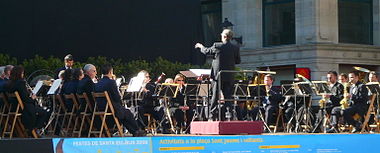- Municipal Band of Barcelona
-
 The Municipal Band of Barcelona, in a concert in the Saint James square of Barcelona during the Santa Eulàlia festivities of 2008
The Municipal Band of Barcelona, in a concert in the Saint James square of Barcelona during the Santa Eulàlia festivities of 2008
The Municipal Band of Barcelona (Catalan: Banda Municipal de Barcelona, IPA: [ˈbandə munisiˈpaɫ də βərsəˈɫonə]) is a music institution with a long tradition, which was founded in 1886.
Contents
History
Beginnings
The Municipal Band of Barcelona had a great social significance when it was founded. Its main aim was to bring the great authors to the ordinary people. During that time only the members of the upper social classes had access to the art.
In fact, Barcelona had already a group of musicians that followed the city authorities since the Middle Ages. The trumpets and the drums had the city shield. They were part of the retinue of the Barcelona City Hall. On some special occasions, the Barcelona City Hall paid for some minstrels, whose function was more recreational for the citizens.
Since 1837 there had been many attempts to constitute it as an independent formation, but it did not happen until 1886.
Important period
In the beginning of the 20th century, it became a very important institution. During this period, Joan Lamote de Grignon i Bocquet leaded this institution and in 1915 he achieved that the institution did not depend any more on the School Music of the city (the present Municipal Conservatory of Barcelona). During this period many important musicians and composers visited and even conducted the band, such as Richard Strauss,[1] Igor Stravinski, Maurice Ravel, among others.
Present time
Nowadays the Municipal Band is an essential part of the festive activities of the city. It takes part in all the important events of the city, such as La Mercè, the Greek festival, the National Day of Catalonia, Santa Eulàlia, The Concerts in l'Auditori, among others.
It also offers regularly School Auditions. This activity has the aim of bringing the classical music to the children (around 9000 children take part in this activity every year).
Conductors
These are the conductors that have leaded this institution along its history:
- Josep Rodoreda i Santigós (1886–1896)
- Antoni Nicolau i Parera (1896–1897)
- Celestí Sadurní i Gurguí (1897–1910)
- Cristòfol Casanyé (1910–1914)
- Joan Lamote de Grignon i Bocquet (1914–1939)
- Ramon Bonell (1939–1957)
- Joan Pich i Santasusana (1957–1967)
- Josep González (1967–1969)
- Enric Garcés Garcés (1969–1979)
- Francesc Elias i Prunera (1979–1980)
- Albert Argudo Lloret (1980–1993)
- Josep Mut (1993–2007)
- Joan Lluís Moraleda i Perxachs (2007–2008, Associate Conductor)
- Jordi Moraleda i Perxachs (2007–2008, Associate Conductor)
- Rafael Grimal Olmos (2007–2008, Associate Conductor)
- Salvador Brotons i Soler (2008-),[2] with the collaboration of Marta Carretón.
References
- ^ On March 1925 Richard Strauss was in Barcelona, in order to conduct some concerts for the Easter season of the Gran Teatre del Liceu, and on 15th he heard in the Plaça del Rei the instrumentation for band that the maestro Lluís Oliva had made from his symphonic poem Death and Transfiguration. Since he was really taken by the quality of this version, he asked to conduct the band, and everyone accepted of course, since it was a great honour. The audition took place on 19th March in the morning in Saint James square, so that more people could hear it. The success was tremendous. The mayor (who was then Darius Rumeu i Freixa) requested Richard Strauss to greet the enthusiastic crowd from the City Hall balcony. [...] Complete article
- ^ Revista Musical Catalana 285-286 July-august 2008
External links
Categories:- Spanish orchestras
Wikimedia Foundation. 2010.
